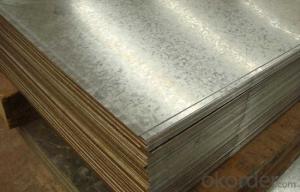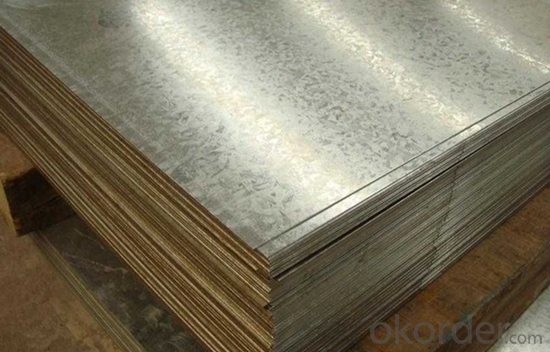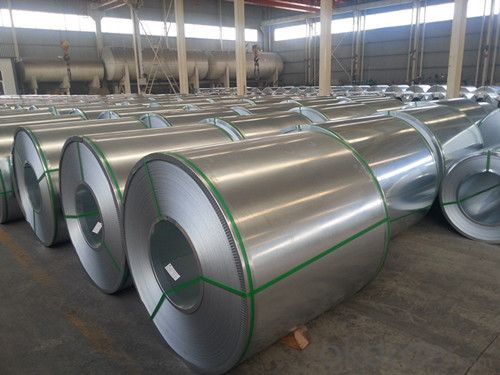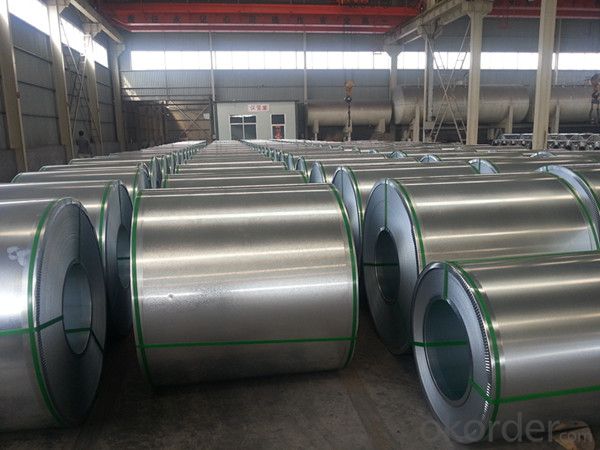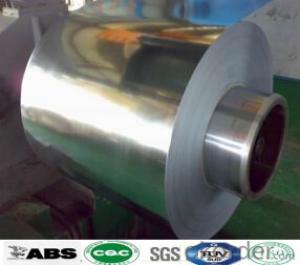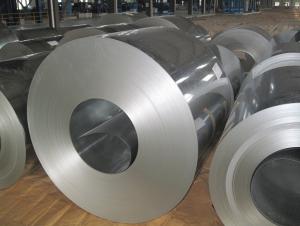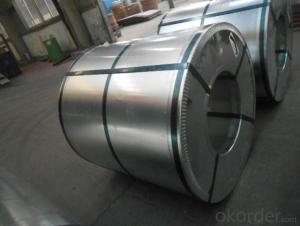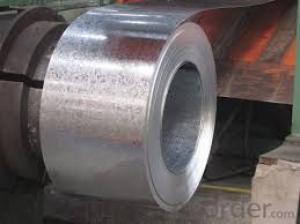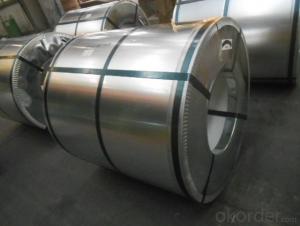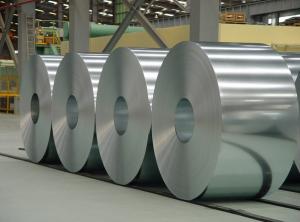Hot Dipp Galvanized Steel in Coils,SGCC,DX51D
- Loading Port:
- China main port
- Payment Terms:
- TT OR LC
- Min Order Qty:
- 25 m.t.
- Supply Capability:
- 100000 m.t./month
OKorder Service Pledge
OKorder Financial Service
You Might Also Like
Hot dip galvanized steel coil and sheet
Hot dip galvanized steel coil and sheet | |
Technical Standard: | JIS 3302 / ASTM A653 / EN10143 |
Grade | DX51D / DX52D/ DX53D/ S250,280,320GD |
Types: | Commercial / Drawing / Deep Drawing / Structural quality |
Width | 500/650/726/820/914/1000/1200/1219/1220/1250mm |
Thickness | 0.12-4.0mm |
Type of coating: | Galvanized |
Zinc coating | Z30-700g/m2 |
Surface Treatment | Chromed / Skin-pass/ Oiled/Slightly Oiled/ Dry/ Anti-fingerprint |
Surface structure: | Zero spangle / minimized spangle / regular spangle/ big spangle |
ID coil | 508mm or 610mm |
Coil weight | 3-12 MT per coil |
Package: | Properly packed for ocean freight exportation in 20''containers |
Application: | Industrial panels, roofing and siding for painting |
Price terms | FOB,CFR,CIF |
Payment terms | T/T or L/C |
Delivery time | Within 30 days |
Remarks | Insurance is all risks |
MTC will be handed on with shipping documents | |
We accept the third party certification test,such as SGS/BV |
Technical data :
Hot dipped galvanized coil Technical Data
Chemical Composition | ||||||
GRADE | C | Si | Mn | P | S | Ti |
SGCC/DX51D+Z | ≤0.10 | ≤0.50 | ≤0.60 | ≤0.10 | ≤0.030 | ≤0.020 |
DX52D+Z | ≤0.10 | ≤0.50 | ≤0.60 | ≤0.10 | ≤0.030 | ≤0.020 |
SGCD/DX53D+Z | ≤0.10 | ≤0.30 | ≤0.50 | ≤0.05 | ≤0.030 | ≤0.020 |
SGCE/DX54D+Z | ≤0.10 | ≤0.30 | ≤0.30 | ≤0.03 | ≤0.020 | ≤0.020 |
DX56D+Z | ≤0.10 | ≤0.30 | ≤0.30 | ≤0.03 | ≤0.020 | ≤0.020 |
Structural | ≤0.20 | ≤0.60 | ≤1.70 | ≤0.10 | ≤0.045 | |
Hot dipped galvanized steel coil Mechanical Properties | |||
GRADE | Yield Strength MPa | Tensile Strength MPa | Elongation % |
SGCC(DX51D+Z) | ≥205 | ≥270 | - |
SGCD(DX53D+Z) | - | ≥270 | 38 |
SGCE(DX54D+Z) | - | ≥270 | 40 |
DX56D+Z | - | ≥270 | 42 |
- Q: How are steel coils coated or painted?
- Steel coils are typically coated or painted using a process known as coil coating. This involves a series of steps including cleaning, pretreating, applying primer, and applying the final topcoat. The coils are first cleaned to remove any dirt or contaminants. They are then pretreated to enhance adhesion and corrosion resistance. After that, a primer is applied to provide a base layer for the paint. Finally, the desired topcoat is applied using various methods such as roll coating, spray coating, or electrostatic coating.
- Q: I'm looking to buy the Milano Stiletto, and it uses 1045 steel. I was just wondering whether this will hold up and keep an edge.
- 1045 Steel
- Q: describe the benifits and disadvantages of the using steel as a material for fasteners
- There are different grades of steels which can suit different application considering corrosion,surrounding atmosphere,pressure,temperature and many more. Let us take the stainless steel fasteners: 1.Resists Rust: The primary advantage to using stainless steel bolts is that they resist rusting. This makes them ideal for outdoor or marine uses, since moisture will not cause them to corrode. Rust basically eats steel and makes it weaker. A rusty, weak bolt can be a serious safety risk, because it can break under a load. 2.Clean: Stainless steel bolts are very easy to clean due to having a higher content of chromium, which creates a lustrous, mirror-like surface that is very smooth. This makes stainless steel an ideal option if aesthetics are an issue. 3.Temperature: Stainless steel has a high melting point, which makes it a good option in machines that are put through immense amounts of heat. The bolts will not fuse together, and can be unfastened when the machines need repairs. Also, in very cold conditions, steel can become brittle. By mixing nickel into the stainless steel, the metal resists becoming brittle at low temperatures. See the source link for details.
- Q: What are the environmental considerations of using steel coils?
- There are several environmental considerations associated with using steel coils. Firstly, the production of steel coils requires a significant amount of energy and raw materials, which can contribute to greenhouse gas emissions and environmental degradation. Additionally, the extraction and processing of iron ore for steel production can have negative impacts on land, water, and air quality. Moreover, the transportation of steel coils, especially over long distances, can result in emissions from vehicles and contribute to pollution. Lastly, the disposal of steel coils at the end of their lifecycle poses challenges as they can be difficult to recycle and may end up in landfills, further contributing to waste accumulation. Overall, the environmental implications of using steel coils highlight the need for sustainable practices in their production, transportation, and disposal.
- Q: What are the main factors that affect the flatness of steel coils?
- The main factors that affect the flatness of steel coils include the quality of the raw material used, the thickness and width of the coil, the temperature and humidity during the manufacturing process, the tension applied during coiling, and the cooling and leveling processes employed.
- Q: What is the average size of a steel coil?
- The average size of a steel coil can vary depending on the specific industry and application, but it is typically around 25,000 to 50,000 pounds in weight and has a diameter ranging from 30 to 72 inches.
- Q: How are steel coils transported?
- Steel coils are typically transported using specialized flatbed trucks or railcars. The coils are carefully loaded onto these vehicles and secured using straps or chains to prevent any movement during transit. In some cases, shipping containers are also used to transport steel coils via cargo ships.
- Q: What are the common methods of painting or coating steel coils?
- The common methods of painting or coating steel coils include coil coating, spray painting, electrostatic painting, and powder coating.
- Q: What is the difference between hot-rolled and cold-rolled steel coils?
- The main difference between hot-rolled and cold-rolled steel coils lies in the production process. Hot-rolled steel coils are made by heating the steel above its recrystallization temperature, causing it to become malleable and allowing it to be rolled into the desired shape. This process results in a thicker and less precise product with a rough surface. On the other hand, cold-rolled steel coils are made by cooling the hot-rolled steel and then passing it through rollers at room temperature. This process enhances the steel's strength, durability, and dimensional accuracy, resulting in a thinner and smoother product that is ideal for applications requiring precision.
- Q: What are the different types of steel coil surface treatment methods?
- Various industries commonly use several different types of surface treatment methods for steel coils. These methods aim to enhance the performance, durability, and appearance of the coils. Some commonly employed treatment methods for steel coils include: 1. Hot-dip galvanizing: Immersing the steel coil in molten zinc provides excellent corrosion resistance and prevents rusting. 2. Electro-galvanizing: Electroplating a thin layer of zinc onto the steel coil surface offers similar corrosion protection to hot-dip galvanizing but with a thinner coating. 3. Cold-rolled steel coil: Passing the steel coil through rollers at room temperature creates a smooth and polished surface finish, suitable for high-quality appearance applications. 4. Pre-painted steel coil: Also known as color-coated steel coil, this method involves applying a layer of paint or coating onto the steel surface, providing an attractive appearance and additional corrosion protection. 5. Phosphating: Applying a phosphate coating onto the steel surface improves the adhesion of subsequent coatings, such as paint or powder coating, and offers corrosion resistance. 6. Chromate conversion coating: This method entails applying a conversion coating, typically using chromium compounds, onto the steel coil surface to enhance paint adhesion and corrosion resistance. 7. Passivation: Chemical treatment is used to remove iron oxide and other contaminants from the steel surface, thereby improving the corrosion resistance of the steel coil. 8. Oiling: A thin layer of oil is applied onto the steel coil surface, commonly used for preventing corrosion during storage and transportation. These treatment methods are commonly employed for steel coil surfaces. The choice of method depends on specific requirements like corrosion resistance, appearance, and performance.
Send your message to us
Hot Dipp Galvanized Steel in Coils,SGCC,DX51D
- Loading Port:
- China main port
- Payment Terms:
- TT OR LC
- Min Order Qty:
- 25 m.t.
- Supply Capability:
- 100000 m.t./month
OKorder Service Pledge
OKorder Financial Service
Similar products
Hot products
Hot Searches
Related keywords
